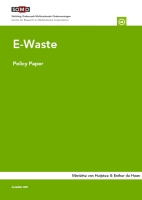
E-waste: how to address the problem?
With a shift in recycling and production of consumer electronics, the E-waste problem can be addressed. The ‘E-waste policy paper’, published today by SOMO, provides proposals for policy and action.
Reports about the piling up of e-waste in Asia and Africa appear in the media virtually every week. The irresponsible disposal of e-waste creates and sustains environmental and social concerns at the beginning and at the end of the electronics life cycle. When metals are not retrieved and recycled from e-waste, the production of new electronics increases the demand for mining of these metals. Metal mining often has destructive environmental effects, and under some circumstances, may impose serious health impacts for the mine workers. At the end of the electronics life cycle, if e-waste is dumped, landfilled or improperly recycled, environmental pollution and health impacts threaten local communities and informal recycling workers in developing countries.
The purpose of this policy paper is to provide European governments, the electronics sector and NGOs with an overview of the current state of affairs on e-waste and to point out avenues to better address the e-waste problem. The current revision of the European Waste Electric and Electronic Equipment (WEEE) directive provides for an important opportunity in this regard. The complexity of the e-waste problem requires a diversified approach in its solution. First, increased collection, re-use and recycling of discarded electronics in Europe is an important element of solving the e-waste problem. If old consumer electronics like mobile phones and laptops are collected separately, the majority of the containing metals can be recycled and reused. Higher recycling rates would mean that fewer new resources would be extracted from the earth, and that the environmental and health costs of our toxic e-waste are no longer paid by developing countries. However, recycling can hardly satisfy the increasing materials demand for the growing production of electronics. Furthermore, innovation trends of electronics seem to complicate easy dismantling and recycling in the future. To address this, a shift towards more ecodesign is needed; designers of future electronics should put an effort in designing out toxics, designing out non-renewables, and design their products in such a way they can be easily dismantled and materials can be retrieved.
The policy paper gives specific policy options and recommendations for governments, companies and civil society groups to increase collection, reuse and recycling, and to stimulate ecodesign.
Related news
-
 The hidden human costs linked to global supply chains in ChinaPosted in category:News
The hidden human costs linked to global supply chains in ChinaPosted in category:News Joshua RosenzweigPublished on:
Joshua RosenzweigPublished on: -
 Major brands sourcing from China lack public policies on responsible exitPosted in category:News
Major brands sourcing from China lack public policies on responsible exitPosted in category:News Joshua RosenzweigPublished on:
Joshua RosenzweigPublished on: -


